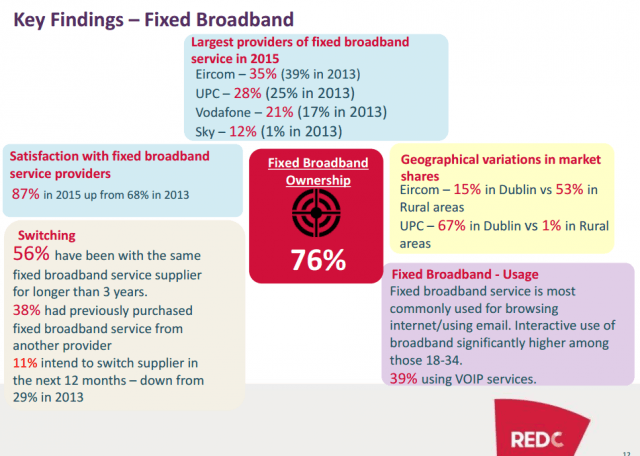Here’s a problem most North Americans wish they had: confusing rate cuts that are coming as a result of fierce competition for your telecom dollar.
In Ireland, the problem is real and some consumers are finding themselves perplexed watching the cost of broadband, telephone, and television service dropping by as much as $159 a year from the four different providers competing across much of the country. Telco Eircom has a 35% market share (39% in 2013), UPC/Virgin Media Cable – 28% (25% in 2013), Vodafone – 21% (17% in 2013), and Sky – 12% (1% in 2013).
“Neighbors are talking to one another and comparing bills only to find some are paying less than others even though they have the same types of services,” says Richard Donahue, a Dublin resident turned compulsive comparison shopper. “Because competition is getting stronger, local providers are pushing to get customers into bundles of services to keep them from switching.”

The result is lower pricing to help convince consumers to take all of their business to one provider. The ongoing drop in the price of telephone, television and broadband service has now been measured by Comreg, Ireland’s telecoms regulator. It released a report this month stating prices have “fallen significantly for the average Irish household.”
Consumers willing to make providers fight for their business are saving over $100 a year on bundled service packages. Comreg reported that even without asking, the average consumer subscribing to a package of television and broadband service has seen prices fall by nearly $75 a year across the board. Those also subscribing to telephone service are paying around $50 less a year. Only the cost of standalone broadband has remained the same, but that price has stayed close to what the Irish consider an acceptable range for Internet access — between $15 and $40 a month.

Irish cable competitor UPC (now Virgin Media) sells a package of 240Mbps broadband with an unlimited calling landline for around $50 a month.
“Standalone broadband pricing may not be falling, but it isn’t rising either,” reports Donahue. “Service has improved with faster speeds and better reliability so you receive better value for money.”
Even mobile service prices are down by almost $90 a year, but there are some caveats.
“Ireland has one significant mobile problem yet to be sorted — the penalty for breaching allowances, which can be substantial,” Donahue said. “Comreg found almost a third of Ireland has received a warning text from a provider about nearing a limit provided by our allowances for voice minutes, texts, or data.”
Donahue adds the Irish are reticent about changing mobile providers, even if it would save them money.
“We love to complain about poor providers in this country that drop calls and leave us without coverage but 73 percent of us have not changed our provider in at least three years,” he reports. “Most don’t believe there are any savings doing so.”
Ireland appears to be a few years behind North American trends dealing with telecom services. The Comreg report found:
- Only 9 percent of Irish households subscribe to Netflix
- 76% of Irish mobile users still text back and forth but are gradually shifting towards app-based messaging services like Hangouts, Facebook Messenger and Whatsapp
- 43% of those watching online video report watching less traditional live/linear TV
- Only about 58% of mobile users browse the web with their phones
- 60% of broadband users couldn’t tell you what broadband speeds they receive/are supposed to receive
- 88% of those 65+ still have landline phone service, while 46% of those 18-24 still use landlines to make and receive calls.


 Subscribe
Subscribe
Phil, am actually in Ireland now & for the last week. Can confirm that the above 4 providers are all advertising bundles on trucks, billboards, radio/TV, and on their service trucks. Saw plenty of fiber digging in Metro Dublin area, in business & residential areas. Spotted all 4 providers digging. Definitely competing for the consumer’s business..